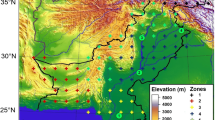Abstract
The study of climate changes in India and search for robust evidences are issues of concern specially when it is known that poor people are very vulnerable to climate changes. Due to the vast size of India and its complex geography, climate in this part of the globe has large spatial and temporal variations. Important weather events affecting India are floods and droughts, monsoon depressions and cyclones, heat waves, cold waves, prolonged fog and snowfall. Results of this comprehensive study based on observed data and model reanalyzed fields indicate that in the last century, the atmospheric surface temperature in India has enhanced by about 1 and 1.1°C during winter and post-monsoon months respectively. Also decrease in the minimum temperature during summer monsoon and its increase during post-monsoon months have created a large difference of about 0.8°C in the seasonal temperature anomalies which may bring about seasonal asymmetry and hence changes in atmospheric circulation. Opposite phases of increase and decrease in the minimum temperatures in the southern and northern regions of India respectively have been noticed in the interannual variability. In north India, the minimum temperature shows sharp decrease of its magnitude between 1955 and 1972 and then sharp increase till date. But in south India, the minimum temperature has a steady increase. The sea surface temperatures (SST) of Arabian Sea and Bay of Bengal also show increasing trend. Observations indicate occurrence of more extreme temperature events in the east coast of India in the recent past. During summer monsoon months, there is a decreasing (increasing) trend in the frequency of depressions (low pressure areas). In the last century the frequency of occurrence of cyclonic storms shows increasing trend in the month of November. In addition there is increase in the number of severe cyclonic storms crossing Indian Coast. Analysis of rainfall amount during different seasons indicate decreasing tendency in the summer monsoon rainfall over Indian landmass and increasing trend in the rainfall during pre-monsoon and post-monsoon months.
Similar content being viewed by others
References
Bhaskar Rao DV, Naidu CV, Srinivasa Rao BR (2001) Trends and fluctuations of the cyclonic systems over North Indian Ocean. Mausam 52(1):37–46
Das PK, Radhakrishna M (1991) An analysis of Indian tide gauge records. Proc Indian Acad Sci (Earth Planet Sci) 100(2):177–194
Das PK, Radhakrishna M (1993) Trends and the pole tide in Indian tide gauge records. Proc Indian Acad Sci (Earth Planet Sci) 102(1):175–183
Dash SK, Rao P (Eds) (2003) Assesment of Climate Change in India and Mitigation Policies, WWF-India, New Delhi
Dash SK, Kumar JR, Shekhar MS (2004) On the decreasing frequency of monsoon depressions over the Indian region. Curr Sci 86(10):1404–1411
De US (2001) Climate change impact: Regional scenario. Mausam 52(1):201–212
Dhar ON, Nandargi S (2001) On some rainfall characteristics at Indian observatories based on the latest normals. J Meteorol 26(258):124–130
Gabriele G, Dube SK, Murty T, Siefert W (2001) Global storm surges theory, observation and applications, edited by Germn Coastal Engineering Research Council, 623
Intergovernmental Panel on Climate Change (IPCC), Climate Change (2001) The Scientific Basis. Third Assessment Report of the Intergovernmental Panel on Climate Change, 2001, Cambridge: Cambridge University Press
Jenamani RK, Dash SK (1999) Interannual and intraseasonal variations of characteristic of monsoon disturbance formed over Bay. Mausam 50:55–62
Jenamani RK, Dash SK (2001) Interdecadal variations of characteristics of monsoon disturbances and their epochal relationships with rainfall and other tropical features. Int J Climatol 21:759–771
Jones PD, New M, Parker DE, Martin S, Rigor IG (1999) Surface air temperature and its changes over the past 150 years. Rev Geophys 37:173–199
Kothawale DR, Rupa Kumar K (2005) On the recent changes in surface temperature trends over India. Geophys Res Lett 32:L18714, doi:10.1029/2005GL023528
Lal M (2003) Global Climate Change: India’s monsoon and its variability. J Environ Stud Policy 6(1):1–34
Lal M, Aggarwal D (2000) Climate Change and its Impacts on India. Asia Pac J Environ Dev 7(1):1–41
Mooley DA, Pant GB (1981) Droughts in India over the last 200 years, their socio-economic impacts and remedial measures for them. In: Climate and History – Studies in Past Climates and their impact on man. TML Wigley et al (eds) Cambridge University Press, pp 465–478
Oliver JE, Wilson L (1987) Climate classification. In: Oliver JE, Fairbridge RW (eds) The Encyclopedia of Climatology, Van Nostrand Reinhold Company, New Work, pp 221–236
Paramanik SK, Jagannathan P (1954) Climate change in India (II)-Temperature. Indian J Meteorol Geophys 5:1–19
Prakasa Rao GS, Jaswal AK, Kumar MS (2004) Effects of urbanization on meteorological parameters. Mausam 55(3):429–440
Ramage CS (1971) Monsoon Meteorology, Academic, New Work, 296 pp
Rupa Kumar K, Krishna Kumar K, Ashrit RG, Patwardhan SK, Pant GB (2002) Climate Change in India: Observations and model projections. In: PR Shukla, SK Sharma, PV Ramana (eds) Climate change and India Issues, Concerns and Opportunities, Tata McGraw-Hill Publishing Company Limited, New Delhi
Singh OP, Ali Khan TM, Md, Rahman S (2000) Changes in the frequency of tropical cyclones over the North Indian Ocean. Meteorol Atmos Phys 75:11–20
Srinivasa Rao BR, Bhaskar Rao DV, Brahmananda Rao V (2004) Decreasing Trend in the strength of tropical easterly jet during the Asian summer monsoon season and the number of tropical cyclonic systems over Bay of Bengal. Geophys Res Lett 31:L14103, doi:10.1029/2004GL019817
Srivastava HN, Dewan BN, Dikshit SK, Prakash Rao GS, Singh SS, Rao KR (1992) Decadal trends in climate over India. Mausam 43(1):7–20
Webster PJ, Holland GJ, Curry JA, Chan, HR (2005) Changes in tropical cyclones number, duration and intensity in a warming environment. Science 309:1844–1846
Author information
Authors and Affiliations
Corresponding author
Rights and permissions
About this article
Cite this article
Dash, S.K., Jenamani, R.K., Kalsi, S.R. et al. Some evidence of climate change in twentieth-century India. Climatic Change 85, 299–321 (2007). https://doi.org/10.1007/s10584-007-9305-9
Received:
Accepted:
Published:
Issue Date:
DOI: https://doi.org/10.1007/s10584-007-9305-9




